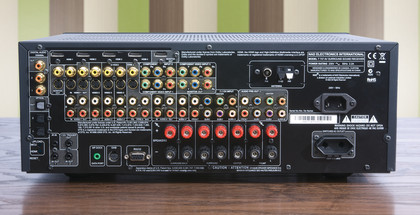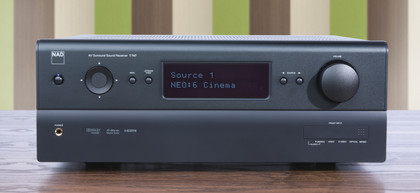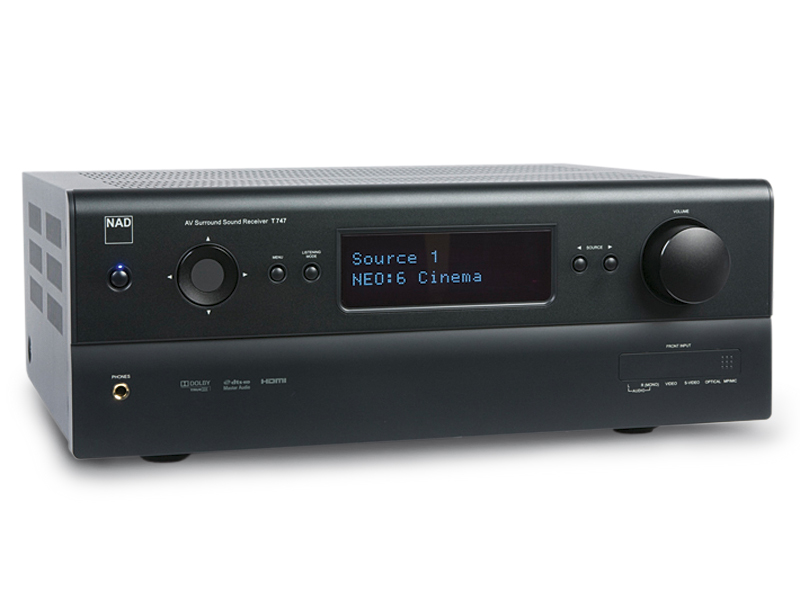TechRadar Verdict
It may lack one or two features, but NAD's receiver offers phenomenal sound for under £1000
Pros
- +
Storming all-round performance
- +
Eases you into every film
- +
Simple to use
Cons
- -
No Ethernet or USB inputs
- -
DAB costs extra
- -
Shortage of Watts for real grunt
Why you can trust TechRadar
NAD has an enviable reputation for delivering superb value for money, especially when performance is a priority. Not actually my words, but NAD's. The claim heads up the NAD T747 product overview and, try as I might, I simply can't disagree.
Over the years, decades in fact, NAD has consistently delivered solid-performing products that have generally sacrificed bells and whistles in favour of better performance for your hard-earned, or benefit-thieved, pound.
But hold the phone! Have you seen the features list of the new T747? It has got auto-set-up with a supplied mic, two remote controls, multizone support, an onscreen GUI, a 1080p video upscaler and a data-dock connection for an iPod – and I've only stopped there because I ran out of breath.
Add-in a comprehensive suite of IR repeaters, 12V triggers, an RS232 port, ample AV sockets and 4-in-1-out v1.3 HDMIs, and top it off with decoding for all our favourite Dolby and DTS HD audio codecs and NAD's own matrix surround sound format, EARS. Ah, makes me chuckle every time.

The 747 has also had a bit of a makeover. Compared to previous NAD receivers, the new properly-black and neatly-curved fascia with blue display elevates it to simply 'plain' – up from butt-ugly. It is not yet mixing it with the likes of Harman Kardon or Pioneer in the style stakes, but lessons learnt from the success of the rather funky Viso components are certainly beginning to show through. Even the remote is topped with a gloss black panel reminiscent of current Samsung TV and BD deck handsets.
Okay, it's missing a few optical digital inputs, the terminals are a bit on the budget side of solid and there is no Ethernet port for networking. But we're talking about a sub-£1,000 receiver here.
Signal failure
This NAD also comes with an optional trump card – a DAB radio module. A £150 premium on top of the base-line model gets you the DB1 DAB module or, for stateside NAD owners, an XM satellite radio tuner.
Whether the DAB tuner is any good is a mystery to me as a decent signal hasn't made it to the South Coast yet – so as most of Sussex and Kent still regard FM and Nicam stereo as 'new-fangled', I do rather miss the net-connection for web radio.
There is a lot going on inside and outside of the NAD for the money, so where's the catch? Has the brand given up on its less-is-more performance-first philosophy and gone all 'gadgety'? I severely hope not, because it will get its corporate backside whipped by Onkyo at this price point.
Predictably, NAD has taken a very modest view of its power output. A mere 7 x 60W is the claimed output, which implies the T747 has all the raw industrial machismo of an energy-saving lightbulb. This rating is buried within a veritable spreadsheet of power figures proclaimed at different impedances, frequencies and phases of the moon.
More reassuringly, our Tech Labs measured the output at 5 x 141W, and having lived with the T747 for a week, I can safely say the power will be 'more than enough' for most people.
Clunky
The T747's set-up is straightforward – or would have been had the review sample had the correct remote control supplied. Yet even using the fascia buttons alone the receiver is up and running in a jiffy compared to, well, pretty much every other £1,000 receiver on the market. On the downside, the onscreen display is more of a colourful menu rather than the photo-realistic GUI's glamming up the competition, and some of the settings are rather coarse.
For example, speaker distance can only be adjusted in 0.3m/1ft increments (many AVRs now go to 1cm) and the relative channel level is adjusted in chunky 1dB steps – the Denons and Pioneers at this price by a factor of 10. Oh, and the auto-set up got the subwoofer level so wrong I lost two fillings to the THX logo clip.
It doesn't really matter, though. The NAD is so easy to adjust that it's almost as quick to set it up manually and the sound is lush and addictive. Playing the Blu-ray release of Monsters, Inc, the T747 rises easily to the challenge of the various vocal tones and the incredible array of different set ambiences.

Listen to Mike and Sulley's dialogue in the hangar and you feel every bit of the vast space, with the NAD creating accurate reverb and echo effects that nail the spatial sensation. Yet switch to a bedroom scene (no, not one of those bedroom scenes...) and you can all but feel the duvet and furniture damping their voices. This accuracy and detail is not uncommon among receivers of this price point, but the T747 manages to elicit the effect with such ease.
Nor is it simply too safe for its own good. As the tempo rises NAD's receiver picks up the pace nicely, adding a little more of everything across the board. Bass gets deeper and faster, the top-end projects further and the soundstage expands to create an even more impressive action vista.
It's not an AVR that will have you 'oohing' and 'ahhhhing' over any one particular facet of its presentation – or perhaps seeking out action-clips for the sake of it – but you won't find anything to point a critical finger at either!
Watts the story?
Push up the volume and you will begin to wonder just where every other manufacturers' Watts are going to. With ample clockwise action on the volume knob the sound simply grows in stature without getting harsh or changing balance – a common trait in less powerful amps.
With large, efficient floorstanding speakers it managed a 100dB (A-WTD average) in-room output with enviable grace, and turned the comic chase scenes in Bolt into sequences worthy of Bullit.
Well, almost. The T747 is every bit as punchy and dynamic as the £1,000 competition, but I discerned a limited maximum SPL. Simply put, the NAD will not go as maxed-out loud as some of its peers, but it does get to medium-serious listening volumes a whole lot more gracefully that many of them.
Will the slightly limited max SPL matter to most people? Probably not – unless you are blessed with stone-deaf neighbours. What the NAD offers instead is an unflappable solidity and cast-iron guarantee that no matter what you throw at it, it will continue to sound great.
A week's listening encompassed a broad brush of Blu-rays – ZZ Top Live in Texas, Monty Python's Life of Brian, Milk and Lesbian Vampire Killers – and the NAD disappeared into the movie-watching experience every time.
The T747 is a capable all-rounder that lulls you with its easy-going style and by being pretty darn good at everything. Denon's equivalent has more chutzpah, Pioneer's more detail and Onkyo's perhaps more refinement, but the T747's simplicity, solidity and consistent performance keeps NAD's reputation for quality and value thoroughly intact. In all, a worthy upgrade for existing NAD faithful.
Follow TechRadar Reviews on Twitter: http://twitter.com/techradarreview
